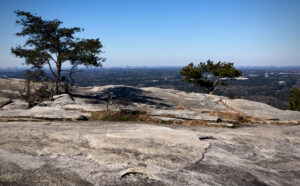
When I got out of the army I spoke with a heavy southern accent I had picked up from my roommate and another friend, who were both from north Florida. A cold caller once said to me in surprise [say this in the heaviest accent you can imagine]: “Good lord, brother. Where are you from, Stone Mountain, Georgia?”
The fact that he named that place as the exemplar, the very heart of southernness, always stuck with me. Sunday I happened to be in the neighborhood for the first time in decades.
What is the opposite of a pilgrimage? I went to take a look largely because Stone Mountain has the infamous bas-relief monument to Confederacy carved into its side, in the figures of Davis, Lee, and Stonewall Jackson. The weather was fine and cool, and the pine woods were pretty on either side of the highway out of Atlanta.
The state park is beautiful, well-used, and well-maintained. It turns out to be the most-visited attraction in Georgia, and at 20 bucks a pop for entry, it seems to be doing okay, though the sky lift was down for annual maintenance, and none of the museums, snack shops or playgrounds that people enjoyed in pre-pandemic times were open. Still, there is a lake and trails around and up the mountain, which rises 825 feet from the countryside, itself about 800 feet above sea level. The granite dome is an anomaly formed by a lava bubble formed deep underground and thrust slowly to the surface over millions of years. The rock sparkles up close when broken, but looks like the gray skin of an elephant from any distance.
The brochure said the one-mile walk to the top was “extremely strenuous,” but people were hiking it with little kids and little dogs under their own power, everyone following a painted yellow line, like a centerline on a road, up the slope, so they did not stray too far to one side or the other and slide off. People have. The mountain reminded me of a Western more than an Eastern terrain feature, and though there are trees, the rock is mostly bare. From the top, Atlanta could be seen 20 miles to the west in the haze.
Once I had walked up and back, I thought about not going to see those guys on their horses. The state park brochure refers to them only as “the carving,” but the sign at the dedicated parking lot advertises “Memorial Hall and carving viewing.” The bas-relief itself looked shallowly-carved in the smoggy backlight of the still-rising sun—more like scratches than I thought it would, and poorly executed—and the terrifying slick steepness of the hill, with its long vertical streaks, dirty dark and light, where water runs off. The carving looked like something weather alone could take back within decades. (It is not.)
A long mall of dormant brown grass ran from the closed Memorial Hall down past stone markers for the states of the Confederacy, and there were tall poles and some sort of aluminum contraption that must be for gatherings and concerts. The place had a smell, which I can only name as old Confederate cemeteries. Down at the base of the mall, under the stone dome, was a pond set up for light shows. It was lightly frozen, and visitors were skipping stones across the ice that made an eerie sound of high-tension wires cutting loose. An eagle catching the light high up by the carving turned out to be a buzzard. The thing is a tacky American disgrace. Work started on it at the time (after the start of the 20th century) that Confederate monuments went up around the country. The dome was also used in what was perhaps the first meeting of the resurgent KKK.
As long as I was in the neighborhood, I thought I should drive the couple of miles to the actual village of Stone Mountain, which is where I assume the cold caller was asking if I was from. It is a pleasant-looking small town, with a longtime German bakery and restaurant, where I bought a slice of strudel, a happy-face cookie, and coffee. It does seem Griswolds live there, so maybe the caller was not being funny.
Stone Mountain was home to the Creek people and then the Cherokee, who chased them out, according to signage in the park. Native Americans were certainly there longer than people of European descent and never would have defaced what was likely a holy place for them. But the geography itself does not care about its human history, which is pleasant to remember on a Sunday morning 157 years after Lincoln died. One day the locals may wish the past did not gift them that carving.
